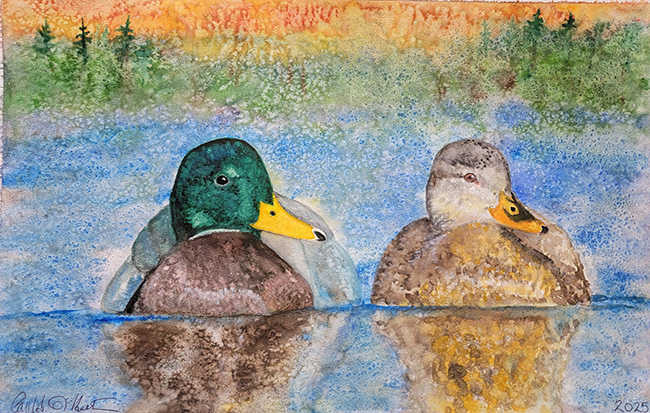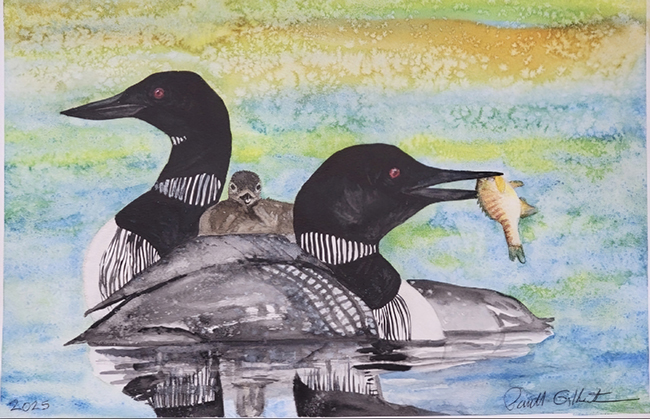Paul ‘Gilby’ Gilbertson is a painter with a curious mind and a love for the outdoors. Born with an experimental streak, Gilbertson has spent decades refining his craft across various techniques. One happy accident in the early 1970s changed the course of his work: he discovered how salt interacts with watercolor. Dropping salt onto wet pigment created unexpected bursts of texture. That moment stuck with him. Over time, he mastered this reaction and made it a trademark of his painting style. What began as a bit of fun became a thoughtful, calculated element of how he builds images—adding atmosphere, mystery, and movement.

Today, Gilbertson’s work balances nature, memory, and experimentation. His watercolor landscapes celebrate the beauty of the Midwest, especially Wisconsin, where he lives. His “salt effect” brings the breeze to the trees and ripples to the water. But behind each painting is a deeper story—of place, of people, and of personal connections.
His two latest paintings, Legacy Loon Lake and Legacy Ducks on the Pond, are exactly that: personal. Both carry the “Legacy” title because they are tributes—to the state of Wisconsin and its wildlife, but also to specific moments, sounds, and memories. Gilbertson is no stranger to painting loons and ducks, but these two pieces are rooted in something more lasting.

Legacy Loon Lake centers around the call of the loon, a bird that holds a special place in the hearts of many who spend time in northern Wisconsin. The painting captures more than just the bird itself—it captures a mood. The viewer feels the calm of a lake at sunset. The sky is soft. The water carries reflections that seem to hum. And somewhere in the middle of it all, the loon cries out. Gilbertson uses salt not just in the background, but around the loon and across the water, giving the piece a sense of stillness and surprise. That salt, scattered with intention, mimics nature’s unpredictability. The painting feels like memory—fragile and glowing.
Then there’s Legacy Ducks on the Pond, which carries a more playful, local energy. This one came about from a family request. Gilbertson’s son-in-law asked for a painting of mallards, which reminded him of his childhood. The image of ducks gliding across the water speaks to long summer days and simple joys. But there’s another layer: the Mallards are also the name of Madison’s Minor League Baseball team. Locals know the “Duck Blind”—a spot in the stadium known for its laid-back vibe, food, and brews. Gilbertson tied both elements together: childhood nostalgia and hometown pride. The result is a quiet scene, but one that feels warm and alive.
While the subject matter might be straightforward—birds, ponds, lakes—the strength of Gilbertson’s work lies in how he invites viewers into the moment. These aren’t just paintings of nature. They are nature, memory, and community filtered through a lens of affection and intention. Every brushstroke seems to carry a reason. Every patch of salt is like a little echo of chance.
Gilbertson doesn’t chase trends or fuss over fine detail for detail’s sake. His work is about feeling. And despite the peacefulness in his subjects, his technique stays curious. The salt effect is never used the same way twice. It moves and settles differently every time, much like weather or water. He welcomes that unpredictability, shaping it but never trying to control it fully. That tension—between design and accident—is part of what gives his work its quiet pull.
Both of these “Legacy” paintings feel like bookmarks in time. They mark what Wisconsin means to the artist and his family. They also show how Gilbertson continues to blend personal experience with artistic exploration. Whether honoring the haunting call of a loon or painting mallards with a baseball team in mind, Gilbertson doesn’t separate art from life. For him, they are one and the same.
It’s easy to appreciate the way these pieces look. But what makes them meaningful is how they feel. That’s always been at the heart of Gilbertson’s work: not just painting what you see, but painting what you remember, what you hear, and what stays with you. And sometimes, all it takes is a little salt to bring it to life.


